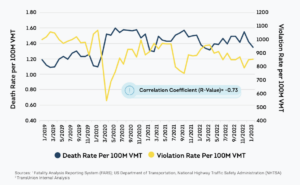At the same time as traffic fatalities increased and motorists’ driving habits deteriorated, law enforcement officers were issuing fewer citations for traffic violations, data analytics company TransUnion says in a new report.
TransUnion gathers traffic violation data from the courts for driving history reports that it sells to insurers. The company says its data shows that US law enforcement issued about 900 citations for violations per 100 million vehicle miles traveled in January 2023, down from a pre-pandemic average of about 1,500 citations per 100 million miles in January 2020.
The violation rate plummeted to less than 700 per 100 million miles during COVID-19 lockdowns in early 2020 and has increased since then, but the number of citations issued remains 13% below pre-pandemic rates, the report says.
TransUnion compared its violation data against death rates calculated by the National Highway Traffic Safety Administration over the same period. The highway fatality rate climbed 22%, from an average of 1.2 deaths per 100 million miles traveled in pre-pandemic years to 1.46 post-pandemic.
“Among many important takeaways from this research is the plain fact that traffic enforcement plays a role in maintaining safety on the road,” Mark McElroy,

executive vice president and head of TransUnion’s insurance business, said in a press release.
McElroy said in an email that during the early days of the pandemic, numerous police departments directed officers to temporarily cease traffic stops for minor violations to prevent the spread of COVID-19 and as a result of staffing shortages.
What’s more, the murder of George Floyd by a Minneapolis police officer in May 2020 launched a nationwide movement to improve the equity of policing. Several jurisdictions banned traffic stops for minor violations.
Numerous media outlets have reported on the decline in traffic enforcement:
- In August 2022, the San Francisco Chronicle, under the headline “What exactly are they doing?,” reported that the 45 officers in city police department’s traffic division had issued an average of only 10 traffic citations per day so far that year. That was a 77% decrease from the average number of citations issued each day in 2010.
- In May 2021, ABC 7 News in Washington D.C. reported that the number of citations issued by Fairfax County, Virginia police declined by 70%, to 37,406 citations in 2020 from 115,627 in the prior year.
- In May 2022, NJ.com reported that the number of speeding citations issued in New Jersey dropped from 130,108 in 2021 from 181,913 in 2019.
Violation rate vs. death rate (Jan. 2019 to Jan. 2023)

Insurers have noticed the degradation in driving habits.
Data broker LexisNexis reported in May that claim severity for both bodily injury and property damage increased 35% since 2019, while collision claim severity jumped 40%. The share of claims that resulted in total losses also increased, to 27% of collision claims in 2002 from 24% in 2021.
Cambridge Mobile Telematics — which supplies equipment that insurers use to monitor driver habits in usage-based insurance programs — reported in April that the amount of time that smart phone devices were used while driving increased 23% in 2022, to two minutes and 12 seconds per trip. Drivers who interact with their phone screens while driving are 240% more likely to crash than drivers who don’t, the report says.
The TransUnion report says lax enforcement is costing insurers money. Insurers adjust rates according to the number of citations a driver has received, typically in the past three years. TransUnion said its internal analysis concluded that the reduction in the number of traffic tickets written resulted in a projected decrease of $200 million in “surcharge revenue.”
Predictive Tool
The number of traffic citations has received is a valuable predictive tool. In 2019, 42% of accidents involved drivers who had traffic violations in the prior three years. In 2022, the share jumped to 51%, “meaning the predictive power of using prior violation history to project future auto insurance losses has increased during this time period, despite a lower number of total violations issued,” the report says.
Poor driving also costs lives. The National Highway Traffic Safety Administration said an estimated 42,795 died in traffic accidents in 2022, a slight decrease from the number killed in 2021, but far above the 2019 total of 36,355.
The TransUnion report says since 2019, there has been a 21% increase in fatal crashes involving occupants who were not wearing their seatbelt, an 18% increase in alcohol-impaired fatal crashes and a 17% increase in speeding involved fatal crashes.
Adam Snider, director of communications for the Governor’s Highway Safety Administration, said his organization has observed a surge in traffic fatalities coincide with a reduced law enforcement presence on the road that started in many parts of the country in 2020.
“Traffic enforcement must be equitable and fair, and it should be focused on the most dangerous behaviors behind the wheel that kill people every day, such as speeding, impaired driving and distracted driving,” Snider said in email. “Equitable enforcement alone won’t reverse the U.S. traffic safety crisis, but it has to be part of a multi-pronged approach to save lives on our roads.”
Was this article valuable?
Here are more articles you may enjoy.


 Poorer Americans Dropped Federal Flood Insurance When Rates Rose
Poorer Americans Dropped Federal Flood Insurance When Rates Rose  Rare Weather Warning Issued as Strong Gusts Fuel Colorado Wildfire Threats
Rare Weather Warning Issued as Strong Gusts Fuel Colorado Wildfire Threats  J&J Talc Jury Awards $1.56 Billion to Asbestos Cancer Victim
J&J Talc Jury Awards $1.56 Billion to Asbestos Cancer Victim  LA Fires Push Insurers’ 2025 Disaster Losses to $107 Billion
LA Fires Push Insurers’ 2025 Disaster Losses to $107 Billion 